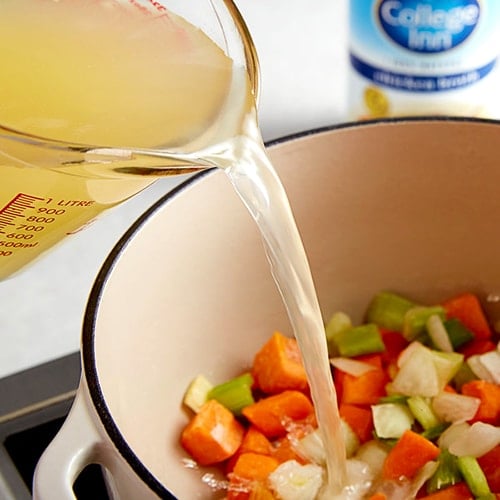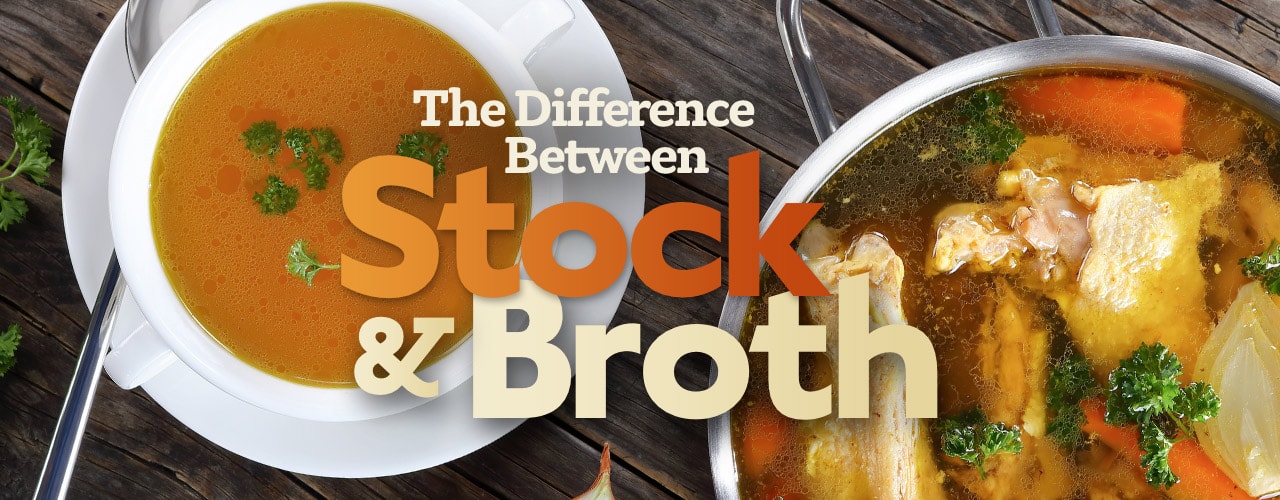As key ingredients in many of the foundational French mother sauces, broth and stock are essential for a variety of dishes. At first glance, the two seem interchangeable, making you wonder, "Are broth and stock the same thing?" While they're similar, broth and stock have many key differences. Read on to compare broth vs stock and learn when to use each one.
Shop All Broths and StocksWhat Is the Difference between Stock and Broth?

Stock is made by simmering bones in water and chefs use it to imbue recipes with a rounder and thicker mouthfeel. Chefs make broth by simmering meat and use it to provide flavor. The main factors that separate stock from broth are their ingredients, seasonings, and cook times. Although many chefs cook with broth and stock similarly, they produce slightly different results and perform best when used appropriately.
Chicken Stock vs Broth
The difference between chicken stock and chicken broth is that chefs make chicken stock with chicken bones and they make chicken broth with chicken meat.
Are Stock and Broth the Same Thing?
Stock and broth are not the same thing, but they can be used in most of the same dishes. However, stock and broth will produce different results. Stock will add thickness to your dish while broth will add more seasoning and liquid. You may water down and season stock to achieve a broth-like consistency. To thicken a broth, add flour or cornstarch to achieve a stock-like consistency. The thickened broth will still contain additional seasoning, so counterbalance it by reducing the seasoning in your recipe.
What Is Stock?

Stock is a liquid flavoring base that is commonly made from chicken or beef bones. However, chefs may use pork or fish bones to make stock as well. A prolonged simmering of the bones releases the collagen and marrow, creating a dense, slightly gelatinous texture that provides a fuller and richer mouthfeel. Stocks are left unseasoned, providing chefs with control over the flavors in their dishes.
How to Make Stock
Stock is made with a combination of animal bones, mirepoix (onions, carrots, and celery), and aromatics like peppercorns, bay leaves, and parsley stems. This combination of ingredients is simmered for 4 to 8 hours, depending on the desired consistency. The longer the cook time, the thicker the stock becomes.
Tips for making stock with a richer flavor and color:
- Leave some meat on the bones
- Add red wine or tomato paste to the bones before simmering
- Roast the bones before simmering
How to Use Stock
Stock is best used as a neutral base for a recipe to enhance the natural flavors and juices of meats while thickening the consistency of the meal. Chefs often use it to replace cream or butter in a recipe. Stock is not meant for independent consumption.
Here are some common dishes that use stock:
- Braised Meats
- Cooked Legumes
- Creamy Soups
- Gumbo
- Gravies
- Sauces
- Stews
What Is Consomme?
Consomme is a concentrated and clarified stock. Chefs clarify their consomme by simmering it with egg whites to remove fat and sediment. They then carefully filter the consomme to achieve total purification.
What Is Broth?

Broth is a culinary enhancer that provides flavor in a liquid form, made by simmering meat in water. It is well-seasoned and maintains a relatively thin and liquid consistency. It is significantly thinner and more flavorful than stock. Being a meat-based liquid, broth is typically made from beef, chicken, or fish. However, it is not uncommon to find vegetable broth.
How to Make Broth
To make broth, simmer meat, mirepoix, and aromatics in water for 45 minutes to 2 hours. To avoid overcooking and drying out the meat, remove any meat pieces from the water after an hour or less. You can either add the meat back in at the end of the broth’s cook time or use it in another recipe. When it's done simmering, strain the broth and season it generously.
How to Use Broth
Because of its thin consistency and flavor, you can use broth for many culinary applications. It can be sipped on its own and is often used as a remedy for illnesses such as the flu or the common cold. Chefs will also use broth in place of water to enhance the flavor of their dishes, such as using broth to boil pasta and steam vegetables.
Here are the most popular ways to use broth:
- Mashed Potatoes
- Rice
- Risotto
- Stuffing
- Dumplings
- Casseroles
- Soups
- Stir Fry
What Is Bouillon?
Bouillion is the French word for broth, so you can use the terms broth and bouillon interchangeably. Bouillon is pronounced as bool-yaan. However, many associate bouillon with bouillon cubes. Bouillon cubes are made from dehydrated meat or vegetable broth. Manufacturers dehydrate broth and then shape the condensed broth into cubes or grind it into powder. All chefs have to do is add the bouillon cubes or powder to water to create a batch of broth. You can purchase cubed chicken, beef, or vegetable bouillon.
What Is Bone Broth?

Bone broth is a hearty and flavorful culinary liquid that is used to enhance a recipe's health benefits. These benefits include providing the body with vitamins and minerals, supporting joint health, improving digestive health, and reducing inflammation. Bone broth is not quite a stock or a broth; it is a combination of the two.
How to Make Bone Broth
Bone broth is made similarly to stock by roasting bones for bone broth and simmering them with some meat in water. The best bones for bone broth include a variety of beef bones and chicken bones. Unlike stock, the cook time of bone broth is approximately 24 hours or more. The purpose of the extended cook time is to extract nutritious compounds and minerals such as amino acids, calcium, electrolytes, and glucosamine along with collagen and marrow. You may also add salt, pepper, garlic powder, apple cider vinegar, and bay leaves to the simmering water to boost the flavor.
How to Use Bone Broth
You can either serve bone broth on its own or use it in recipes. To serve bone broth on its own, strain and season it after it's cooked and then serve it warm. Discover some popular dishes where you may use bone broth to enhance the recipe below:
When in doubt about broth vs stock, choose a low-sodium option of either stock or broth so you have more control over the flavor of your dish and can adjust the recipe to your liking. If your recipe becomes too salty, use our guide to fixing over-salted foods to readjust it.



